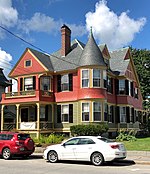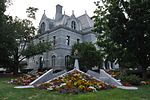Concord () is the capital city of the U.S. state of New Hampshire and the seat of Merrimack County. As of the 2020 census the population was 43,976, making it the 3rd most populous city in New Hampshire after Manchester and Nashua. Governor Benning Wentworth gave the city its current name in 1765 following a boundary dispute with the neighboring town of Bow; the name was meant to signify the new concord, or harmony, between the two towns.The area was first settled in 1659. On January 17, 1725, the Province of Massachusetts Bay, which then claimed territories west of the Merrimack, granted the Concord area as the Plantation of Penacook.: 107 It was settled between 1725 and 1727 and, on February 9, 1734, the town was incorporated as "Rumford." In 1808, Concord was named the official seat of state government. The State House was completed in 1819 and remains the oldest U.S. state capitol wherein the legislature meets in its original chambers.Concord is entirely within the Merrimack River watershed and the city is centered on the river. The Merrimack runs from northwest to southeast through the city. The city's eastern boundary is formed by the Soucook River, which separates Concord from the town of Pembroke. The Turkey River passes through the southwestern quarter of the city. The city consists of its downtown, including the North End and South End neighborhoods, along with the four villages of Penacook, Concord Heights, East Concord, and West Concord. Penacook sits along the Contoocook River, just before it flows into the Merrimack.
As of 2020, the top employer in the city was the State of New Hampshire, and the largest private employer was Concord Hospital. Concord is home to the University of New Hampshire School of Law, New Hampshire's only law school; St. Paul's School, a private preparatory school; NHTI, a two-year community college; the New Hampshire Police Academy; and the New Hampshire Fire Academy. Concord's Old North Cemetery is the final resting place of Franklin Pierce, 14th President of the United States.Interstate 89 and Interstate 93 are the two main interstate highways serving the city, and general aviation access is via Concord Municipal Airport. The nearest airport with commercial air service is Manchester–Boston Regional Airport, 23 miles (37 km) to the south. There has been no passenger rail service to Concord since 1981. Historically, the Boston and Maine Railroad served the city.









